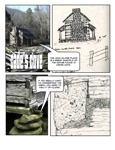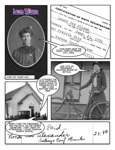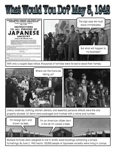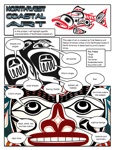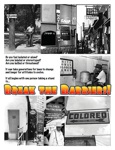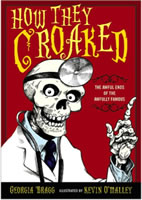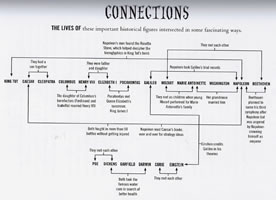 Spotlight Challenge: Making It Work
Spotlight Challenge: Making It Work
How do you go beyond answering questions and writing paragraphs without taking more time?
According to Wineburg, Martin, and Chauncey (2012, ix), "facts are crucial to historical understanding, but there's only one way for them to take root in memory: Facts are mastered by engaging students in historical questions that spark their curiosity and make them passionate about seeking answers."
Explore the following three examples from Wineburg's new book (2012, ix) that examine how history can be made exciting by asking engaging questions.
- "Did 10-year-old Matoaka, known to the rest of the world as Pocahontas, save Captain John Smith from mortal danger, or was this a figment of Smith's supple imagination, a spicy tale designed to boost book sales for his 1624 Generall Historie of Virginia, New England & the Summer Isles?"
Check out The Generalle Historie of Virginia, New England & The Summer Isles by Captaine John Smith. - "Was Abraham Lincoln a racist? Depends. It racism an ethereal quality unaffected by time and place, or are all historical judgements, particularly moral ones, conditioned by circumstances and conventional wisdom?
Check out political cartoons of the time. - "Did Federal policy lead to the Dust Bowl crisis? Or was the real crisis caused by arrogance, the belief that armed with new technologies, human beings were immune tot he fluctuations of Mother Nature?"
- Check out an image from the Dust Bowl.
Try It!
What are your favorite big history questions? How could they be connected with documents?
The Problem. Students will only pay attention in 5-10 minute segments.
The Solution. Break your big questions into smaller concepts. Develop concept-focused lectures that focus on one idea and an example:
- Definition: provide a definition and visual examples
- Perspective: the documents that represent three different people's perspectives
- Cause and effect: relate to event or relationship
- Model an approach: Show a photo and analyze as a group
The Problem. Class projects take too much time!
The Solution. Focus your efforts on the essential questions and don't get bogged down with technology.
Example. How Laws Are Made
- Content. Use of online resources such as infographics for learning such as How Laws are Made.
- Connections. Use the Thomas and Congress.Gov website to make contacts, track real bills, and share findings
Comics
Comics are a quick and easy way for students to share their understandings. It's easy to incorporate original images and artwork along with historical primary source materials.
If you have funding, purchase Comic Life. It's worth the subscription costs.
Or, consider online tools. For those services that don't provide an option to print or save, consider creating a screen shot.
- Pixton. Use the free version or consider the school version.
- Alternatives
- Bitstrips. Need to sign-in to save.
- Cartoonist from Creaza
- Chogger
- Comic Creator
- Comic Master
- KABAM. Restricted to the story and theme provided.
- MakeBeliefs Comix. You can print or email your comic. No storage.
- Professor Garfield. Provides characters for stories.
- Strip Generator. Sign-in required to save and publish. Print without sign-in.
- ToonDoo
- Witty Comics
You don't need use Comic Life or online tools, consider other software in your school. For instance, use the speech bubbles in Microsoft PowerPoint to simulate a conversation among famous historical figures. Keep the project simple by working in small groups and using existing technology tools.
Let's explore three examples:
- What Would You Do? May 3, 1942. Ask students to analyze primary sources, then integrate these primary source materials into a fictional story. Students take on the role of a participant in history.
- Northwest Coastal Art. Ask students to use primary source to teach others.
- Break the Barriers! Ask students to apply historical photos to create a Public Service Announcement (PSA) for today. The student project applies images from the Jim Crow era to GLBT bullying issues today.
- Gettysburg. Ask students to document the instructional unit and reflect on their experiences and understandings.
Explore some comic examples:
Try It
Brainstorm assignments that could include a comic element as a product. Discuss the pros and cons of comic projects.
Interactive Images
Turn static documents into interactive images by using existing software like PowerPoint as well as interactive online tools like SpeakingImage and Thinglink.
In PowerPoint you can add "Action" buttons. If you want them to be transparent, set the fill and line color to No Fill and No Line.
Explore examples of online interactive image projects:
Focus on interesting and unusual primary sources. Look for images with lots of images, text to interpret, and a title to examine such as Chain of Events in American History (poster) (1887): shows images from discovery to 1980s.
Glogster also works well for this type of assignment. Use the search tool for lots of examples such as The Constitution.
Try It!
Discuss a primary source document that could be used for an interactive images project. What would the assignment look like? How would it be assessed?
Infographics
Explore the Government: Who Takes Care of What infographic. What can students learn from infographics?
Explore some others:
Find infographics using Google Images. Do searches for infographics and timelines.
You don't need to create whole infographics. Show students At the National Conventions: the Words They Used. Ask them to create two Wordles for famous speeches they want to compare.
Diana Laufenberg's class create infographics to tell the stories of the top ten worst man-made environmental disasters in American history.
She began with three essential questions:
- What is the balance between the interests of individual and the interests of business with regard to the environment?
- What role should the government play in regulating that balance?
- How do the country’s past actions inform its current policies related to environmental issues?
Laufenberg suggests exploring infographics to get you started thinking about man-made disasters:
Explore websites with suggested top ten lists:
Involve students in creating criteria for evaluating infographics:
- 10 Tips for Designing Infographics
- How to Create an Effective Infographic
- Periodic Table of Visualization
- Themes for a Good Infographic
Although young people often embrace technology, it can also be overwhelming. Establish structured environments for young people to explore, create, and share. Use online creation tools
- Chartle
- Createagraph
- Easelly *
- Infogr.am *
- LucidChart
- ManyEyes
- Picktochart
- Popplet
- Venngage
- Visually *
Go to my Library History course for a page on making infographics.
Try It
What infographics will you look for in Google Images?
Map Projects
Explore existing map projects available on Google Maps.
While you might not be reading "How They Croaked" by Georgia Bragg in class, students may be checking it out on their own. We want them going to Google Maps to locate the death site, exploring Find-A-Grave, and analyzing the diagram of relationships.
There are many mashup websites that combine history and mapping. Explore some examples:
You can also make your own. The Digital History project incorporated Library of Congress primary resources into a mapping project related to Dec 7, 1941.
The Civil Rights Digital Library contains maps linked to primary source documents. Students could connects these with books they are reading such as The Watsons Go to Birmingham - 1963.
Go to Google LitTrips to extend the idea to include trips associated with books.
For any book students are reading, ask them to use Google Maps to locate the area and create their own map adding primary sources.
Assign students different readings and use a map to bring the experience together. For instance, read different historical fiction books related to the Civil War. Maps the locations.
NASA's Outline Maps provide a great starting point for student projects. Bring them into Google Draw or other programs.
Explore tools for creating your own maps:
- Google Mapmaker
- MyGreatMaps and MapMaker 2.0. Perfect for elementary and middle schools.
- National Geographic MapMaker Interactive
- National Altas Mapmaker
- Old World Map Maker. Great for elementary school. Create an "old world" map.
Try It!
Brainstorm a way to incorporate more opportunities for map making into your social studies classes.
Online Tools
Online tools are available for a wide range of history activities
Tools
- APUSH Review Timeline (student produced)
- DocsTeach from National Archives
- Life Timeline
- National Archives: Create a Movie
- Propaganda Filmaker
Timelines are particularly useful in history teaching. Try an online timeline maker.
- Tikitoki. Provides tools for creating a timeline with text, images, audio, video, and links.
- Alternatives
There are many other online tools for helping students organize and share ideas.
- Acrostic Poem, Alphabet Organizer, BioCube, CD/DVD Creator,Comic Creator, Comparison Map, Compare/Contrast,Crossword Puzzles, Diamante Poem, Doodle Splash, Drama Map, Essay Map, FlipBook, Graphic Map, Letter Generator, Persuasion Map, Profile Publisher, Timeline, 2 Circle Venn, 3 Circle Venn, Word Matrix
Think about how social media tools course be used. For instance, an academic librarian created LIKE pages for two former students. Read the Wired Campus article. You can "like" their new pages at Leola Lewis and Joe McDonald.
The That a Man Can Stand project used blog postings as a way for students to share their understandings. They also published their own book. Lulu and Createspace are good options for publishing.
Try It!
What could you publish with your students?
Oral Histories
Start by exploring the many online sites that organize oral histories. Spend some time with students evaluating the approach taken by the interviewer.
Examples:
Use one of the many only analysis sheets: Library of Congress, History Matters,
Apply online tools to conducting Oral Histories: American Folklife Center, Listening to History Lesson
Check out Great Depression Cooking on Youtube and the Cooking with Carla website. Use the Greatest Engineering Achievements page to stimulate question ideas.
Use primary source documents to add interest to an oral history project. Use Stixy to organize ideas.
What else can you do with people in history? Read The not-so-famous person report for ideas.
Scrapbooking
Go to my escrapbooking website for lots of examples of integrating primary sources into projects.
Video Production
Video production doesn't need to be time consuming or expensive. Follow these rules:
- Record it three times and take the best.
- Use what you have.
- Keep it short! (3-5 minutes)
Focus on primary sources and show lots of examples. Visualize a primary source document using animation or video. Watch Gettysburg Address.
Create a music video based on a primary source document. Connect history with music through music videos from History for Music Lovers with songs like Renaissance Man or French Revolution. Make your own! Use the new YouTube for Schools if you don't have access.
Show student productions for inspiration.
Incorporate primary sources including historical video.
Make It Meaningful
Seek ways to make learning meaningful through personal and local connections. I'm working on the diary of my GGGGGrandfather William Preston. He was a private under Captain Dearborn and part of the Quebec Expedition in 1775 commanded by Col. Benedit Arnold. It's exciting to compare the diary of one man with what was happening at this time period in American history.
How will you make learning exciting for your students?American Revolution
- Benedict Arnold's Army: The 1775 American Invasion of Canada During the Revolutionary War by Arthur S. Lefkowitz
- The Notorious Benedict Arnold by Steve Sheinkin
- Through a Howling Wilderness (Google Limited Preview) by Thomas A. Desjardin
- The Real Benedict Arnold (Google Limited Preview) by Jim Murphy
- Washington at Valley Forge by Russell Freedman
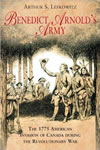


Resources
Hoodless, Pat (2002). History and English in the Primary School: Exploiting the Links. Routledge.
Mallett, Margaret (2010). Choosing and Using Fiction and Non-fiction 3-11. Routledge.


